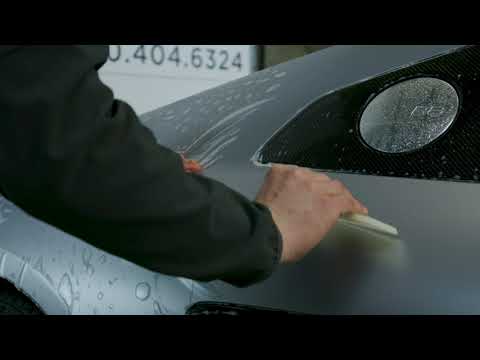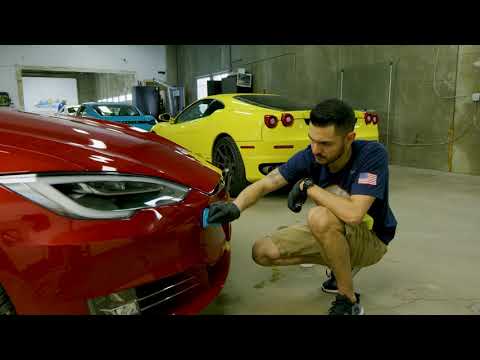If you’re considering tinting your automobile windows, you may have encountered the term “metalized window tint.” But what exactly is it, and how does it differ from other types of window tint? In this blog post, we’ll explore the ins and outs of metalized tints and help you decide if it’s the right choice for your vehicle.
What is Metalized Window Tint? Auto window tinting offers numerous benefits, from reducing heat and glare to enhancing privacy and protecting against UV rays. Metalized window tint is a popular option that utilizes tiny metallic particles to achieve these effects. But what sets it apart from other types of window tint options? Join us as we delve into the world of metalized tint and explore its advantages and considerations.

- What is Metalized Tint?
- The Benefits of Window Tinting
- Types of Metalized Window Tint
- What’s the Difference Between Window Tint and Window Film?
- What are Common Types of Film?
- What is the Cost of Metalized Tints?
- Installing the Metalized Films
- Maintenance
- Final Thoughts
What is Metalized Tint?
The metalized tint is a type of window film that includes a layer of metalized particles that produce a reflective surface. This layer helps to reflect heat and block out harmful UV rays, making it an effective solution for reducing heat and glare in vehicles or buildings.
The Benefits of Window Tinting
Window tinting offers several benefits, including protection against harmful UV rays, reduction of infrared light and radio transmission, and enhancing a shiny appearance. With tinting, you can protect yourself and your belongings from the damaging effects of UV light, reduce heat and sun glare from infrared light and radio signals, and achieve a sleek and stylish look.
- UV Protection: Tinting blocks harmful UV rays, protecting your skin and preventing fading or damage to your leather seats and interior.
- Reduction of Infrared Light and Radio Waves: Tinted windows can significantly reduce the heat and the danger of glare entering your space, making it more comfortable and energy-efficient.
- Shiny Appearance: Tinting enhances the aesthetic appeal of your windows, giving them a sleek and stylish look while maintaining privacy and security.
Types of Metalized Window Tint
Metalized window tint is a type of film that contains tiny metal particles to provide various benefits, such as heat rejection, UV protection, and privacy.
Here are some common types of metalized tints and films:
- Dyed Window Tint: This type of tint uses a layer of dye to darken the windows. It absorbs and blocks sunlight, reducing heat and glare. It does not provide as much heat rejection as other types of tints. The dye absorbs heat, and the metalized particles reflect it, providing a balance between heat reduction and visibility.
- Hybrid Window Tint: Hybrid tints combine both dyed and metalized layers metalized and dyed films. They offer a balance between heat rejection and visibility. The metalized layer helps reflect heat, while the dye provides additional shading.
- Carbon Metalized Window Tint: Carbon window tints use carbon particles to block sunlight and reduce heat. They are known for their high heat rejection capabilities and can block harmful UV rays. Carbon tints provide a sleek, dark appearance or black appearance.
- Ceramic Window Tint: Ceramic window tint is made by embedding ceramic particles into the film. (Ceramic films are made using ceramic nanoparticles). It provides excellent heat rejection, reduces glare, and blocks UV rays. Ceramic tints are known for their durability and clarity, making them a popular choice for high-end vehicles.
- Reflective Window Film: Reflective films have a metalized layer that reflects sunlight and heat away from the windows. They provide high heat rejection and privacy by creating a mirrored appearance on the outside. However, they may interfere with electronic signals and are not suitable for all applications.
- Security Window Film: Security films are designed to enhance the strength and shatter resistance of windows. They are made with multiple layers of polyester and a strong adhesive. While they may not provide significant heat rejection, they offer added protection against break-ins, accidents, and even natural disasters.
- UV-Blocking Metalized Window Tint: UV-blocking metalized window tint is designed to block harmful UV rays from entering the windows. It helps to protect the occupants and interior of vehicles or buildings from the damaging effects of UV radiation.
- Privacy Window Tint: Privacy films are typically darker and offer increased privacy by reducing visibility from the outside. They can be dyed, carbon, or metalized, depending on the desired level of privacy. These tints are commonly used in commercial buildings, residential properties, and vehicles.

What’s the Difference Between Window Tint and Window Film?
Window tint and window film are often used interchangeably, but there is a slight difference between the two.
Window tint refers to a thin, colored film that is applied to the interior or exterior surface of car windows. It is primarily used to reduce the amount of sunlight and heat that enters the vehicle, providing privacy and protection from UV rays.
Window tint is usually made from a polyester film that is dyed or metalized to achieve the desired color and level of tint.
On the other hand, window film is a broader term encompassing various types of films used for automotive windows.
The film can include not only tinted films but also other types of films with different functionalities, such as:
1. Solar Control Film: This type of film is designed to block a significant amount of heat and UV rays, reducing the interior temperature of the car and protecting the occupants from harmful radiation.
2. Security Film: Security films are thicker and stronger than regular window tint. They are designed to hold the glass together in case of an accident or break-in, providing added safety and preventing shattered glass from flying around.
3. Privacy Film: Privacy films are often used for commercial vehicles or personal cars that require increased privacy. They make the windows opaque or reflective from the outside, preventing people from seeing inside the car.
4. Decorative Film: Decorative films are used to enhance the aesthetic appeal of car windows. They come in various patterns, designs, and colors, allowing individuals to customize the appearance of their vehicles.
5. Anti-Glare Film: Anti-glare films are designed to reduce glare caused by sunlight or headlights, enhancing visibility and reducing eye strain for the driver.
Some popular brands and types of window tints and films include:
- 3M Window Films
- LLumar Window Films
- SunTek Window Films
- Solar Gard Films
- Huper Optik Films
- XPEL Window Films
- Avery Dennison Films
- Johnson Films
- V-Kool Films
- Madico Films
It is important to check local regulations and window tint laws regarding window tint and film darkness levels, as different jurisdictions have specific restrictions on the amount of tint allowed on vehicle windows.
What are Common Types of Film?
Common types of car window film include tinted film, which reduces glare and blocks harmful UV rays, and security film, which adds an extra layer of protection by making it more difficult for them to shatter.
- Ceramic Tint Film
- Carbon Tint Film
- Metalized Film
- Hybrid Film
- Dyed Window Tint Film
- Metallic Tint
Common Types of Car Window Film Include:
1. Dyed Film: This type of film is made by applying a layer of dye to the film, which helps to reduce heat and glare. It is a more affordable option but does not provide as much heat rejection as other types.
2. Metalized Window Film: This film contains tiny metallic particles that reflect heat and UV rays away from the car’s interior. It provides better heat rejection and can also enhance the strength of the automotive glass. However, it may interfere with electronic devices such as GPS or cell phone signals.
3. Carbon Window Film: Carbon tint film is known for its excellent heat rejection properties and durability. It blocks significant heat and UV rays while maintaining a sleek appearance. It does not interfere with electronic devices and is less likely to fade.
4. Ceramic Tint Film: Ceramic film uses advanced nanotechnology that incorporates ceramic particles into the film. This type of film offers superior heat rejection, blocks out nearly all UV rays, and reduces glare. It also does not interfere with electronic devices and provides excellent clarity.
5. Crystalline Window Film: Crystalline film is a high-performance film with heat rejection while maintaining a clear appearance. It is designed to block out a significant amount of heat and UV rays without darkening the windows. It also offers enhanced visibility and reduces glare.
6. Security Film: Security film is a thicker film designed to strengthen the glass surface and prevent it from shattering upon impact. It provides additional protection against break-ins and can help hold shattered glass together in an accident.
It is important to check local laws and regulations regarding the darkness and reflectivity of car tint films, as different states and countries have different restrictions.

What is the Cost of Metalized Tints?
The cost of Metalized tints can vary depending on various factors, such as the type of vehicle, the size of the windows, the quality of the tint, and the location of the installation.
Here are some example prices for different types of vehicles:
1. Compact Car: The price of metalized tints for a compact car can range from $100 to $300. This price may include the installation of metalized tints on all windows, including the front windshield.
2. Sedan: The cost of metalized tints can range from $200 to $500 for a sedan. This price may include the installation of metalized tints on all glass surfaces, excluding the front windshield.
3. SUV or Van: Metalized tints for an SUV or van can range from $300 to $700. This price may include the installation of metalized tints on all automotive glass, excluding the front windshield.
4. Luxury or Sports Car: The price of metalized tints for a luxury or sports car can have an extra cost. It can range from $500 to $1000 or more. This price may include the installation of high-quality metalized tints on all of the vehicle’s glass surfaces, excluding the front windshield.
It’s important to note that these prices are just examples and can vary depending on the specific requirements and preferences of the vehicle owner. Price may also vary based on the location and reputation of the tinting service provider. Getting quotes from multiple providers and comparing their prices and services is recommended before deciding.
Installing the Metalized Films
Installing metalized films on car windows is a relatively straightforward process that can be done by professionals or experienced DIY enthusiasts. The films are carefully measured and cut to fit the specific dimensions of each window and then applied using a specialized adhesive. Ensuring the installation is done correctly is essential to avoid air bubbles or uneven application.
Installing metalized window films on car windows offers numerous benefits, including heat and glare reduction, UV protection, privacy, security, and improved visibility. It is a cost-effective way to enhance the appearance and functionality of a vehicle while providing comfort and protection for its occupants.
Maintenance
Metalized window tint is popular for car owners due to its durability and heat rejection capabilities. However, like any other car accessory, it requires proper maintenance to ensure longevity and effectiveness.
Here are some tips on how to maintain metalized window tint for cars:
- Regular cleaning is essential to keep your metalized window tint clear and free from dirt or debris.
- Avoid harsh cleaners:
- Use a soft cloth when cleaning the metalized window tint
- Avoid sharp objects
- Protect from extreme heat
- Regular inspection
By following these maintenance tips, you can ensure that your metalized window tint for cars remains in good condition, providing you with long-lasting heat rejection, privacy, and style. Regular cleaning and proper care will help preserve the appearance and functionality of the tint, allowing you to enjoy its benefits for years to come.
Final Thoughts
In conclusion, metalized window tint for cars is essential for aesthetics and functionality. It not only enhances the appearance of your vehicle but also protects from harmful UV rays, reduces heat buildup, and increases privacy.
To enjoy these benefits, consider installing metalized tints on your car today. Take action now and find a reputable window tinting service provider near you to get started on improving your driving experience.




